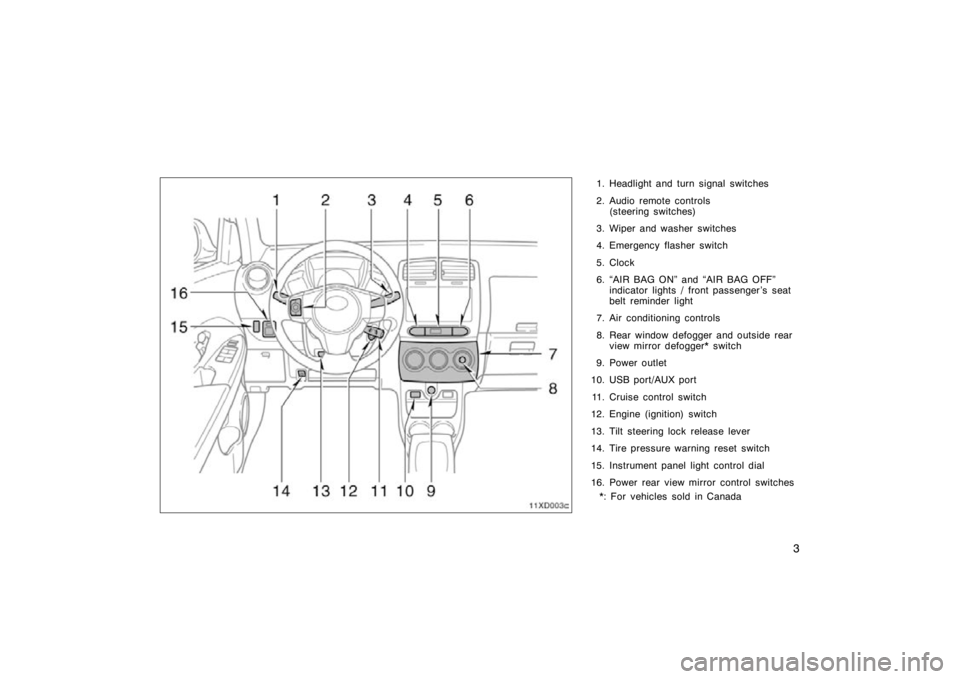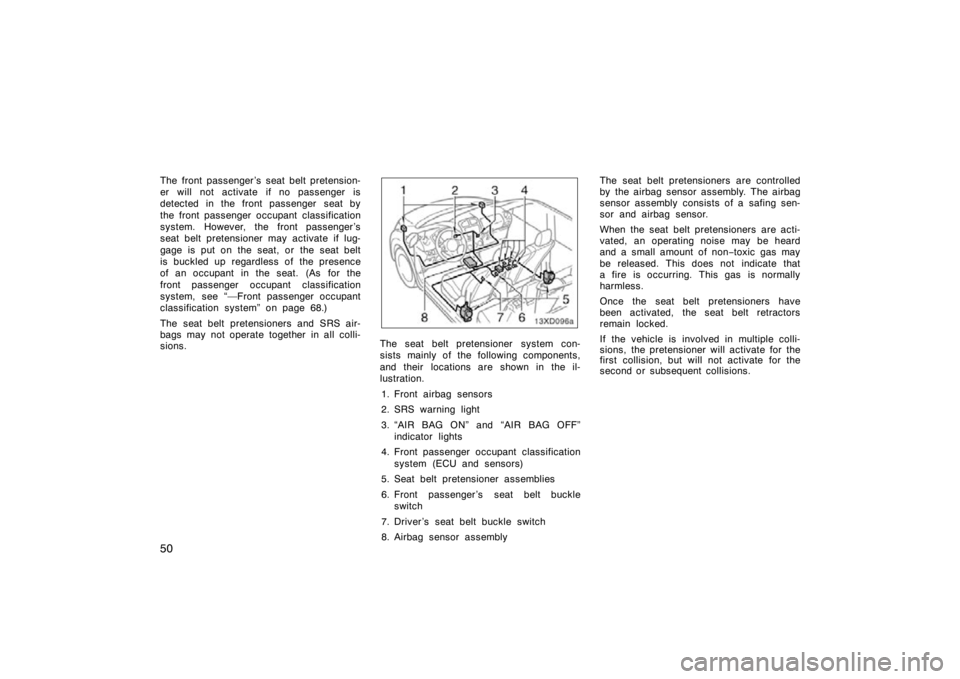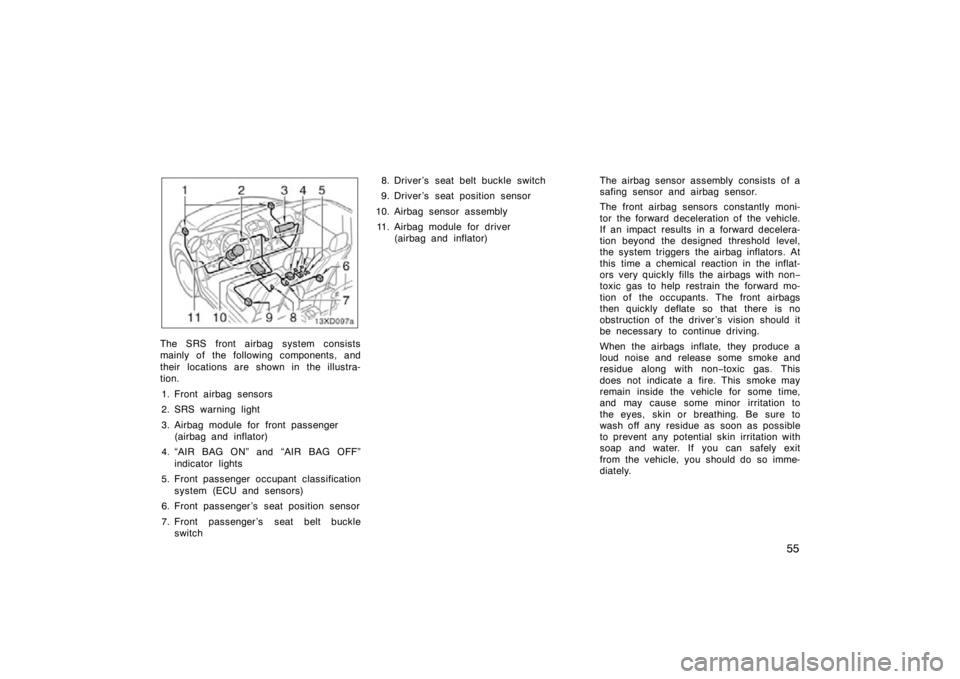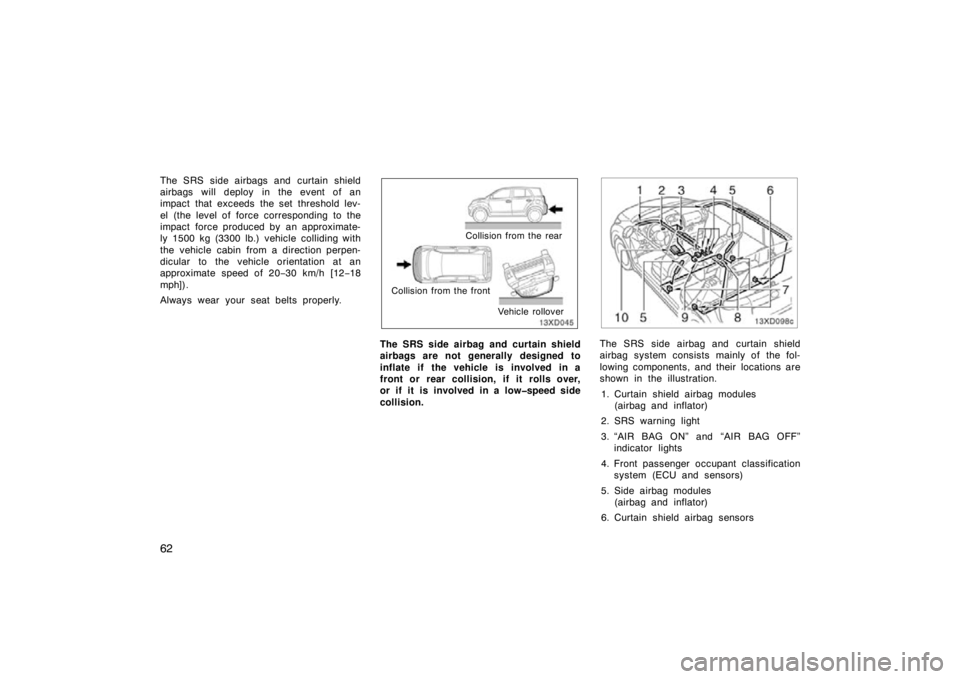warning lights TOYOTA xD 2011 Owners Manual (in English)
[x] Cancel search | Manufacturer: TOYOTA, Model Year: 2011, Model line: xD, Model: TOYOTA xD 2011Pages: 318, PDF Size: 3.72 MB
Page 11 of 318

3
1. Headlight and turn signal switches
2. Audio remote controls(steering switches)
3. Wiper and washer switches
4. Emergency flasher switch
5. Clock
6. “AIR BAG ON” and “AIR BAG OFF” indicator lights / front passenger ’s seat
belt reminder light
7. Air conditioning controls
8. Rear window defogger and outside rear view mirror defogger* switch
9. Power outlet
10. USB port/AUX port
11. Cruise control switch
12. Engine (ignition) switch
13. Tilt steering lock release lever
14. Tire pressure warning reset switch
15. Instrument panel light control dial
16. Power rear view mirror control switches *: For vehicles sold in Canada
Page 14 of 318

6
Turn signal indicator lights
Headlight high beam indicator light
Cruise control indicator light*
3
*1: For details, see “Service reminder indicators and warning
buzzers” on page 113.
*2: For details, see “Engine coolant temperature indicator and warning light” on page 108.
*3: If this light flashes, see “Cruise control” on page 140.
“AIR BAG ON” and “AIR BAG OFF”
indicator lights
Headlight low beam indicator light
Low fuel level warning light*1
Tire pressure warning light*1
Slip indicator light*1
“TRAC OFF” indicator light
Tail light indicator light
Page 58 of 318

50
The front passenger ’s seat belt pretension-
er will not activate if no passenger is
detected in the front passenger seat by
the front passenger occupant classification
system. However, the front passenger ’s
seat belt pretensioner may activate if lug-
gage is put on the seat, or the seat belt
is buckled up regardless of the presence
of an occupant in the seat. (As for the
front passenger occupant classification
system, see “—Front pass enger occupant
classification system” on page 68.)
The seat belt pretensioners and SRS air-
bags may not operate together in all colli-
sions.
The seat belt pretensioner system con-
sists mainly of the following components,
and their locations are shown in the il-
lustration.
1. Front airbag sensors
2. SRS warning light
3. “AIR BAG ON” and “AIR BAG OFF” indicator lights
4. Front passenger occupant classification system (ECU and sensors)
5. Seat belt pretensioner assemblies
6. Front passenger ’s seat belt buckle switch
7. Driver ’s seat belt buckle switch
8. Airbag sensor assembly The seat belt pretensioners are controlled
by the airbag sensor assembly. The airbag
sensor assembly consists of a safing sen-
sor and airbag sensor.
When the seat belt pretensioners are acti-
vated, an operating noise may be heard
and a small amount of non
−toxic gas may
be released. This does not indicate that
a fire is occurring. This gas is normally
harmless.
Once the seat belt pretensioners have
been activated, the seat belt retractors
remain locked.
If the vehicle is involved in multiple colli-
sions, the pretensioner will activate for the
first collision, but will not activate for the
second or subsequent collisions.
Page 63 of 318

55
The SRS front airbag system consists
mainly of the following components, and
their locations are shown in the illustra-
tion.1. Front airbag sensors
2. SRS warning light
3. Airbag module for front passenger (airbag and inflator)
4. “AIR BAG ON” and “AIR BAG OFF” indicator lights
5. Front passenger occupant classification system (ECU and sensors)
6. Front passenger ’s seat position sensor
7. Front passenger ’s seat belt buckle switch 8. Driver ’s seat belt buckle switch
9. Driver ’s seat position sensor
10. Airbag sensor assembly 11. Airbag module for driver (airbag and inflator) The airbag sensor assembly consists of a
safing sensor and airbag sensor.
The front airbag sensors constantly moni-
tor the forward deceleration of the vehicle.
If an impact results in a forward decelera-
tion beyond the designed threshold level,
the system triggers the airbag inflators. At
this time a chemical reaction in the inflat-
ors very quickly fills the airbags with non
−
toxic gas to help restrain the forward mo-
tion of the occupants. The front airbags
then quickly deflate so that there is no
obstruction of the driver ’s vision should it
be necessary to continue driving.
When the airbags inflate, they produce a
loud noise and release some smoke and
residue along with non −toxic gas. This
does not indicate a fire. This smoke may
remain inside the vehicle for some time,
and may cause some minor irritation to
the eyes, skin or breathing. Be sure to
wash off any residue as soon as possible
to prevent any potential skin irritation with
soap and water. If you can safely exit
from the vehicle, you should do so imme-
diately.
Page 70 of 318

62
The SRS side airbags and curtain shield
airbags will deploy in the event of an
impact that exceeds the set threshold lev-
el (the level of force corresponding to the
impact force produced by an approximate-
ly 1500 kg (3300 lb.) vehicle colliding with
the vehicle cabin from a direction perpen-
dicular to the vehicle orientation at an
approximate speed of 20−30 km/h [12 −18
mph]).
Always wear your seat belts properly.
Collision from the rear
Collision from the front Vehicle rollover
The SRS side airbag and curtain shield
airbags are not generally designed to
inflate if the vehicle is involved in a
front or rear collision, if it rolls over,
or if it is involved in a low�speed side
collision.The SRS side airbag and curtain shield
airbag system consists mainly of the fol-
lowing components, and their locations are
shown in the illustration.1. Curtain shield airbag modules (airbag and inflator)
2. SRS warning light
3. “AIR BAG ON” and “AIR BAG OFF” indicator lights
4. Front passenger occupant classification system (ECU and sensors)
5. Side airbag modules (airbag and inflator)
6. Curtain shield airbag sensors
Page 79 of 318

71
Condition and operation in the front passenger occupant classification system
Condition detected by
the front passenger
occupant classification
system
Indicator/ warning lightDevices
“AIR BAG ON”
and “AIR BAG
OFF” indicator lightsSRS warning
lightFront
passenger’s seat belt
reminder lightFront
passenger airbagSide airbag on
the front
passenger seatCurtain shield
airbag in the front
passenger sideFront
passenger’s seat belt
pretensioner
1. Adult*1“AIR BAG ON”OffFlashing*4Activated
2. Child*2 or child
restraint system*3“AIR BAG OFF”*5OffFlashing*4Deactivated
Activated
Activated
3. UnoccupiedNot illuminatedOffOffDeactivatedDeactivated
4. There is a malfunction in the system“AIR BAG OFF”OnOffDeactivatedActivated
*1: The system judges a person of adult size as an adult. When a smaller adult sits in the front passenger seat, the system may
recognize him/her as a child depending on his/her physique and posture.
*2: When a larger child who has outgrown a child restraint system sits in the front passenger seat, the system may recognize him/her
as an adult depending on his/her physique or posture.
*3: Never install a rear −facing child restraint system on the front passenger seat. A forward− facing child restraint system should only
be installed on the front passenger seat when it is unavoidable. (See “Child restraint” on page 73 as for installing the child restraint
system.)
*4: When the front passenger does not wear a seat belt.
*5: In case the indicator is not illuminated, see “Child restraint” on page 73 as for installing the child restraint system proper ly.
Page 252 of 318

244
Exhaust system
If you notice any change in the sound of
the exhaust or smell exhaust fumes, have
the cause located and corrected immedi-
ately. (See “Engine exhaust cautions” on
page 167.)
INSIDE THE VEHICLE
Items listed below should be checked
regularly, e.g. while performing periodic
services, cleaning the vehicle, etc.
Lights
Make sure the headlights, stop lights, tail
lights, turn signal lights, and other lights
are all working. Check headlight aim.
Service reminder indicators and warning
buzzers
Check that all service reminder indicators
and warning buzzers function properly.
Steering wheel
Check that it has specified free play. Be
alert for changes in steering condition,
such as hard steering or strange noise.Seats
Check that all front seat controls such as
seat adjusters, seatback recliner, etc. op-
erate smoothly and that all latches lock
securely in any position. Check that the
head restraints move up and down
smoothly and that the locks hold securely
in any latched position. For folding
−down
rear seatbacks, check that the latches
lock securely.
Seat belts
Check that the seat belt system such as
buckles, retractors and anchors operate
properly and smoothly. Make sure the belt
webbing is not cut, frayed, worn or dam-
aged.
Accelerator pedal
Check the pedal for smooth operation and
uneven pedal effort or catching.
Clutch pedal
Check the pedal for smooth operation.
Brake pedal
Check the pedal for smooth operation and
that the pedal has the proper clearance.
Check the brake booster function.
Brakes
In a safe place, check that the brakes do
not pull to one side when applied. Parking brake
Check that the lever has the proper travel
and that, on a safe incline, your vehicle
is held securely with only the parking
brake applied.
Automatic transmission “Park” mecha-
nism
Check the lock release button of the shift
lever for proper and smooth operation. On
a safe incline, check that your vehicle is
held securely with the shift lever in “P”
position and all brakes released.
OUTSIDE THE VEHICLE
Items listed below should be performed
from time to time, unless otherwise
specified.
Fluid leaks
Check underneath for leaking fuel, oil, wa-
ter or other fluid after the vehicle has
been parked for a while. If you smell fuel
fumes or notice any leaks, have the cause
found and corrected immediately.
Doors and engine hood
Check that all the side doors and back
door operate smoothly and all latches lock
securely. Make sure the engine hood sec-
ondary latch secures the hood from open-
ing when the primary latch is released.